Abstract
Purpose
To determine the incidence (1991∼1993) and survival rates (1991∼2003) of retinoblastoma in Korea.
Methods
Data of all Korean patients diagnosed with retinoblastoma from 1991–1993 were retrospectively collected by the hospi-tal-based national registry based on notifications from physicians who are able to diagnose retinoblastoma. The incidence rate (1991∼1993) was calculated per 100,000 childbirths (dividing the number of retinoblastoma patients by the total number of childbirths). The survival rate (1991∼2003) was calculated using the Kaplan– Meier method, and the differences were evaluated with the logrank and Wilcoxon tests and Cox's proportional hazards model. In addition, the clinical findings and prognostic factors associated with survival rate were analyzed.
Results
There were a total of 108 distinct patients diagnosed with retinoblastoma in the registry. The incidence of retinoblastoma in Koreawas 4.99 per 100,000 childbirths, and the survival rate for 13 years (1991–2003) was 77.8%. The survival rate was significantly lower in the population of bilateral retinoblastomapatients, as compared to unilateral retinoblastoma patients. Optic nerve invasion was found to be an independent variable for the reduction of survival rate, although its effects were not significant.
Conclusions
In the present study, the incidence and survival rates of retinoblastoma in Koreawere presented for the first time. The incidence rate was similar to rates reported from other countries. On the other hand, the survival rate was lower than those in European and the United States. In particularly, the survival rate was significantly lower in patients with bilateral retinoblastoma.
Go to : 
References
1. Harbour JW. Overview of RB gene mutations in patients with retinoblastoma. Implications for clinical genetic screening. Ophthalmology. 1998; 105:1442–7.
2. Yu YS, Kim IJ, Ku JL, Park JG. Identification of four novel RB1 germline mutations in Korean retinoblastoma patients. Hum Mutat. 2001; 18:252.

3. Gallie BL, Erraguntla V, Heon E, Chan HS. Retinoblastoma in Pediatric Ophthalmology and Strabismus by Taylor D, Hoyt CS. 3rd ed.Edinburgh: Blackwell Scienece;2005. p. 486–9.
4. MacCarthy A, Birch JM, Draper GJ, et al. Retinoblastoma in great Britain 1963–2002. Br J Ophthalmol. 2009; 93:33–7.

5. Broaddus E, Topham A, Singh AD. Incidence of retinoblastoma in the USA: 1975–2004. Br J Ophthalmol. 2009; 93:21–3.

6. Saw SM, Tan N, Lee SB, et al. Incidence and survival abdominal of retinoblastoma in Singapore from 1968–1995. J Pediatr Ophthalmol Strabismus. 2000; 37:87–93.
7. Nguyen MQ, Nguyen CH, Kramarova E, Parkin DM. Incidence of childhood cancer in Ho Chi Minh city, Vietnam, 1995–97. Paediatr Perinat Epidemiol. 2000; 14:240–7.

8. Sahu S, Banavali SD, Pai SK, et al. Retinoblastoma: problems and perspectives from India. Pediatr Hematol Oncol. 1998; 15:501–8.

9. Gunalp I, Gunduz K, Arslan Y. Retinoblastom in Turkey: abdominal and clinical characteristics. Ophthalmic Genet. 1996; 17:21–7.
10. Mullaney PB, Karcioglu ZA, al-Mesfer S, Dowaidi M. Retinoblastoma referral patterns in Saudi-Arabia. Ophthalmic Epidemiol. 1996; 3:35–46.
11. Moll AC, Kuik DJ, Bouter LM, et al. Incidence and survival of abdominal in the Netherlands: a register based study 1862–1995. Br J Ophthalmol. 1997; 81:559–62.
12. Yang JG, Yu YS. Clinical characteristics of the retinoblastoma abdominal before one year old. J Korean Ophthalmol Soc. 1996; 37:1005–11.
13. Lee TW, Yang SW, Kim BH. Clinical analysis of retinoblastoma. J Korean Ophthalmol Soc. 1995; 36:2162–71.
14. Han SB, Kim JH, Choung HK, et al. The clinical course of abdominal patients who underwent bilateral enucleation. J Korean Ophthalmol Soc. 2007; 48:1234–41.
15. Park JH, Chung HK, Khwarg SI, Yu YS. Clinical course of abdominal regression of bilateral retinoblastoma. J Korean Ophthalmol Soc. 2006; 47:2047–52.
16. MacCarthy A, Birch JM, Draper GJ, et al. Retinoblastoma: abdominal and survival in Great Britain 1963 to 2002. Br J Ophthalmol. 2009; 93:38–9.
17. Naseripour M, Nazari H, Bakhtiari P, et al. Retinoblastoma in Iran: outcomes in terms of patients'survival and globe survival. Br J Ophthalmol. 2008; 93:28–32.
18. Broaddus E, Topham A, Singh AD. Survival with retinoblastoma in the USA: 1975–2004. Br J Ophthalmol. 2008; 93:24–7.

19. The Committee for the National Registry of Retinoblastoma. Survival and risk factors for patients with retinoblastoma in Japan. Jpn J Ophthalmol. 1992; 36:121–31.
20. Yang HK, Kim JH, Choung HK, et al. Combination of abdominal and transpupillary thermotherapy for retinoblastoma. J Korean Ophthalmol Soc. 2008; 49:1619–28.
21. Song JS, Lee JK, Lee TW. Treatment and prognosis of abdominal:clinicopathologic analysis of 101 cases. J Korean Ophthalmol Soc. 1998; 39:2393–405.
22. Kim JH, Yu YS, Khwarg SI, et al. Clinical results of prolonged abdominal chemotherapy in retinoblastoma patients. Korean J Ophthalmol. 2003; 17:35–43.
23. Tamboli A, Podgor MJ, Horm JW. The incidence of abdominal in the United States: 1974 through 1985. Arch Ophthalmol. 1990; 108:128–32.
24. Singh AD, Shields CL, Shields JA. Prognostic factors in retinoblastoma. J Pediatr Ophthalmol Strabismus. 2000; 37:134–41.

25. Stannard C, Lipper S, Sealy R, Sevel D. Retinoblastoma:correlation of invasion of the optic nerve and choroids with prognosis and metastases. Br J Ophthalmol. 1979; 63:560–70.
26. Kopelman JE, McLean IW, Rosenberg SH. Multivariate analysis of risk factors for metastasis in retinoblastoma treated by enucleation. Ophthalmology. 1987; 94:371–7.

27. Goddard AG, Kingston JE, Hungerford JL. Delay in diagnosis of retinoblastoma: risk factors and treatment outcome. Br J Ophthalmol. 1999; 83:1320–3.

28. Abramson DH, Mendelsohn ME, Servodidio CA, et al. Familial retinoblastoma:where and when? Acta Ophthalmol Scand. 1998; 76:334–8.
29. Yu YS. Hereditary retinoblastoma. J Korean Med Assoc. 1995; 38:456–63.
30. Yu YS, Lee TW, Song JS. Four families of hereditary retinoblastoma. J Korean Ophthalmol Soc. 1996; 37:2148–52.
31. Shields CL, De Potter P, Himelstein BP, et al. Chemoreduction in the initial management of intraocular retinoblastoma. Arch Ophthalmol. 1996; 114:1330–8.

32. Murphree AL, Villablanka JG, Deegan WF 3rd, et al. Chemotherapy plus local treatment in the management of intraocular retinoblastoma. Arch Ophthalmol. 1996; 114:1348–56.

33. Kingston JE, Hungerford JL, Madreperla SA, Plowman PN. Results of combined chemotherapy and radiotherapy for advanced intraocular retinoblastoma. Arch Ophthalmol. 1996; 114:1339–43.

34. Wilson MW, Czechonska G, Finger PT, et al. Chemotherapy for eye cancer. Surv Ophthalmol. 2001; 45:416–44.

35. Hamel P, Heon E, Gallie BL, Budning AS. Focal therapy in the management of retinoblastoma: when to start and when to stop. J AAPOS. 2000; 4:334–7.

36. Gallie BL, Budning A, DeBoer G, et al. Chemotherapy with focal therapy can cure intraocular retinoblastoma without radiotherapy. Arch Ophthalmol. 1996; 114:1321–8.

37. Shields CL, Shields JA, Needle M, et al. Combined abdominal and adjuvant treatment for intraocular retinoblastoma. Ophthalmology. 1997; 104:2101–11.
38. Munier FL, Verwey J, Pica A, et al. New developments in external beam radiotherapy for retinoblastoma:from lens to normal tis-sue-sparing techniques. Clin Experiment Ophthalmol. 2008; 36:78–89.
Go to : 
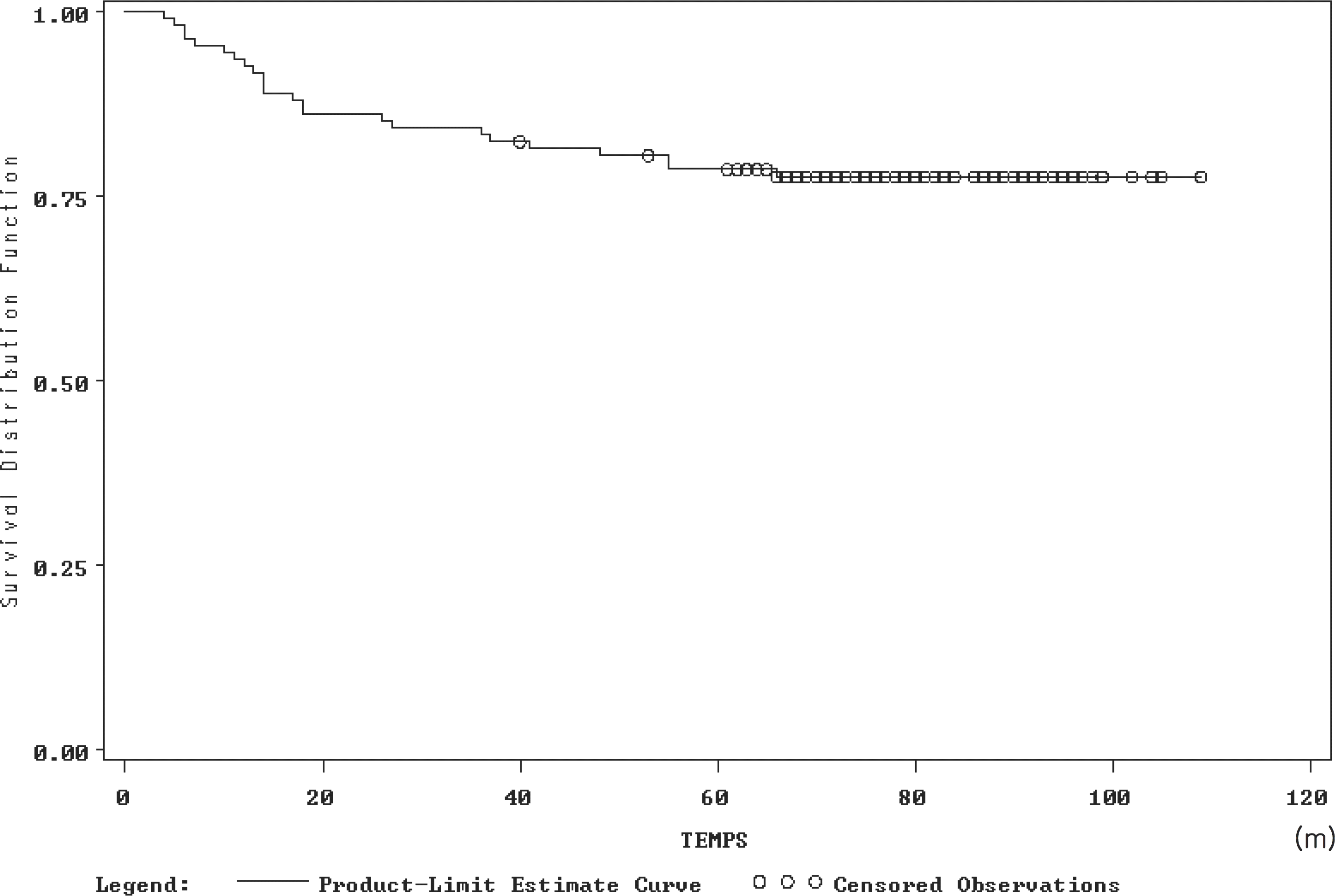 | Figure 1.Survival curve produced by the Kaplan-Meier method for the 108 retinoblastoma patients. |
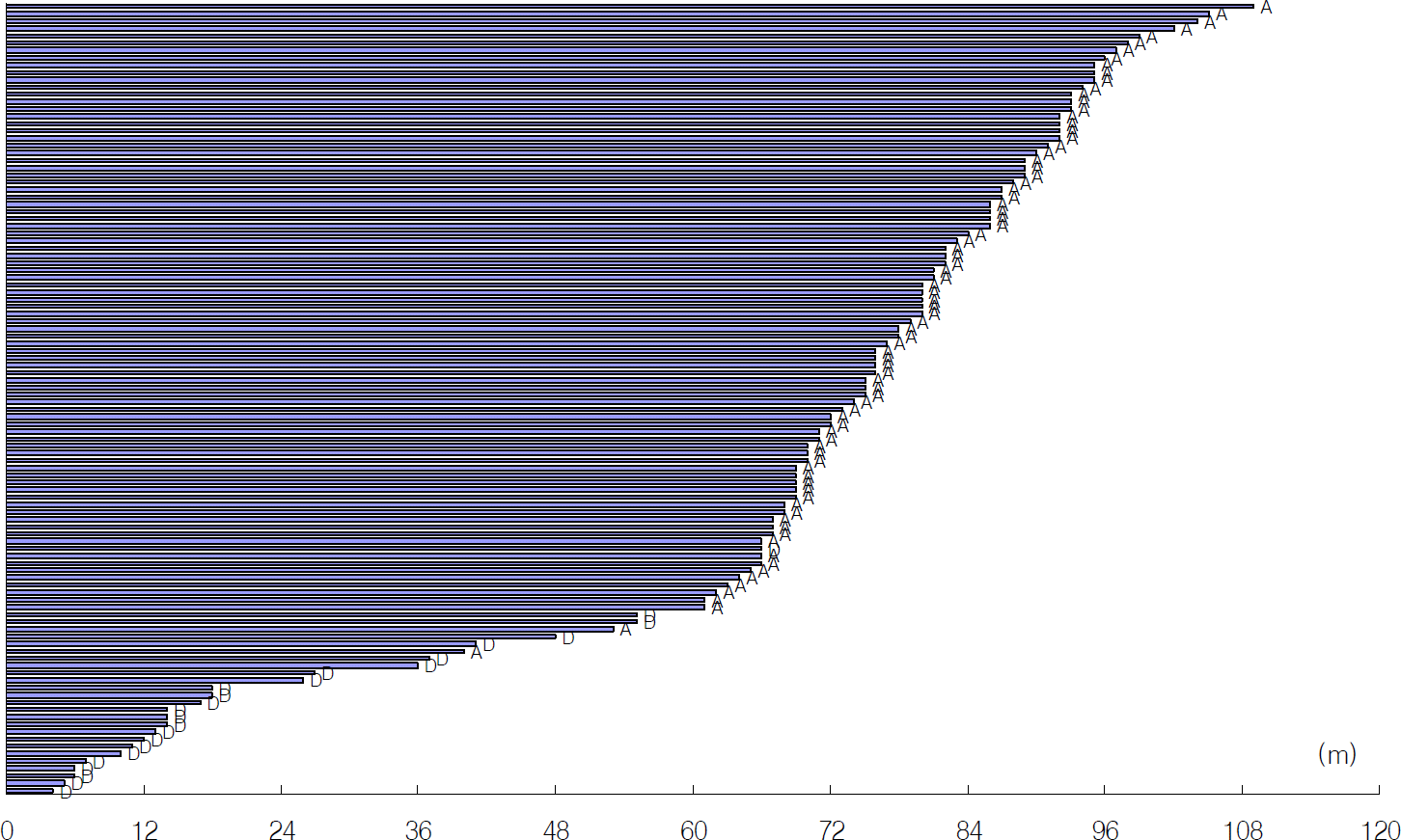 | Figure 2.Data ordered by the length of observed survival time, with (D) representing dead and (A) alive at the end of the follow-up period. |
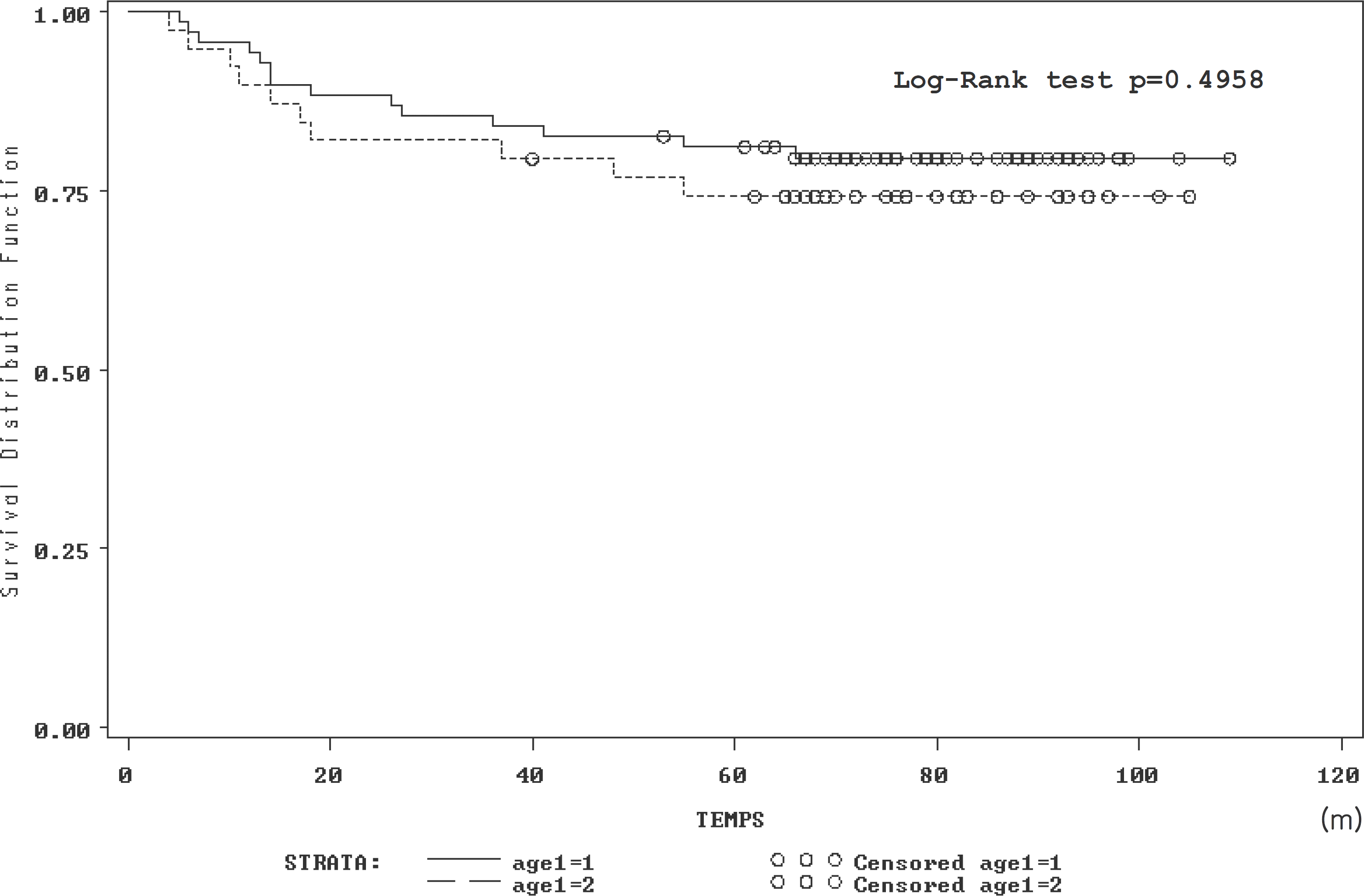 | Figure 3.Survival curve produced by the Kaplan-Meier method for the 108 retinoblastoma patients according to age at diagnosis (≤1 y vs. 2 y ≤). |
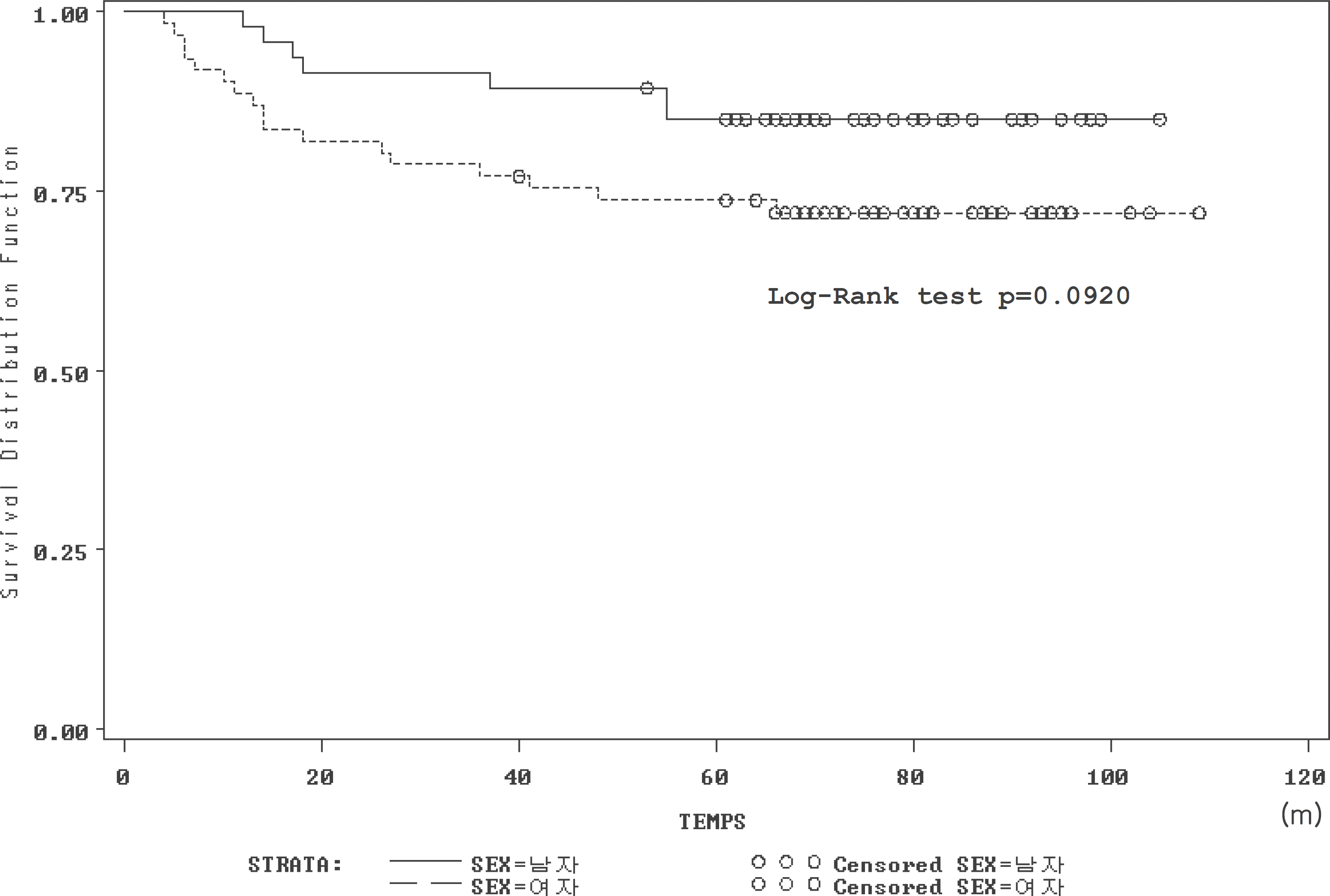 | Figure 4.Survival curve produced by the Kaplan-Meier method for the 108 retinoblastoma patients according to sex. |
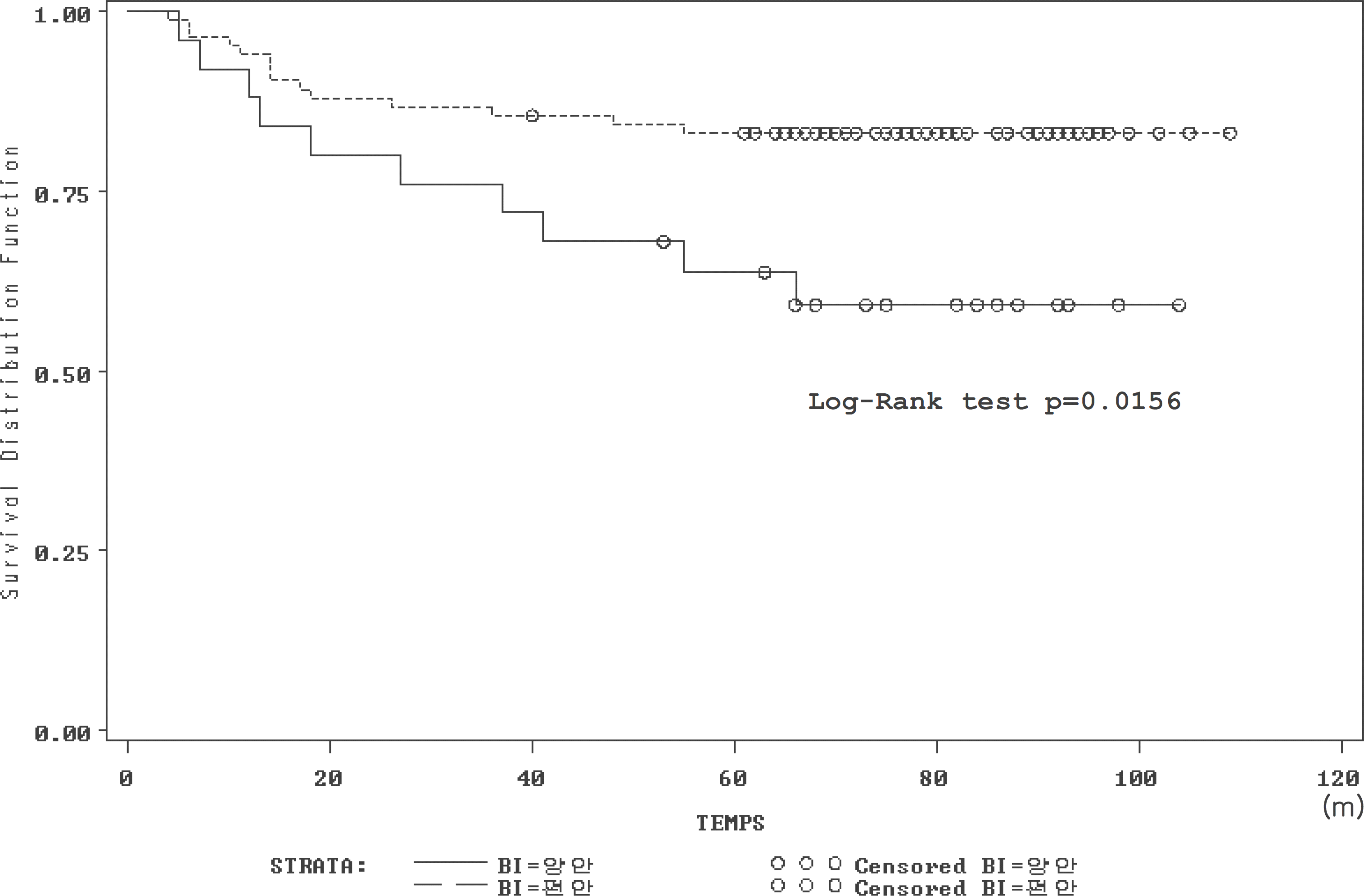 | Figure 5.Survival curve produced by the Kaplan-Meier method for the 108 retinoblastoma patients according to bilateral status. |
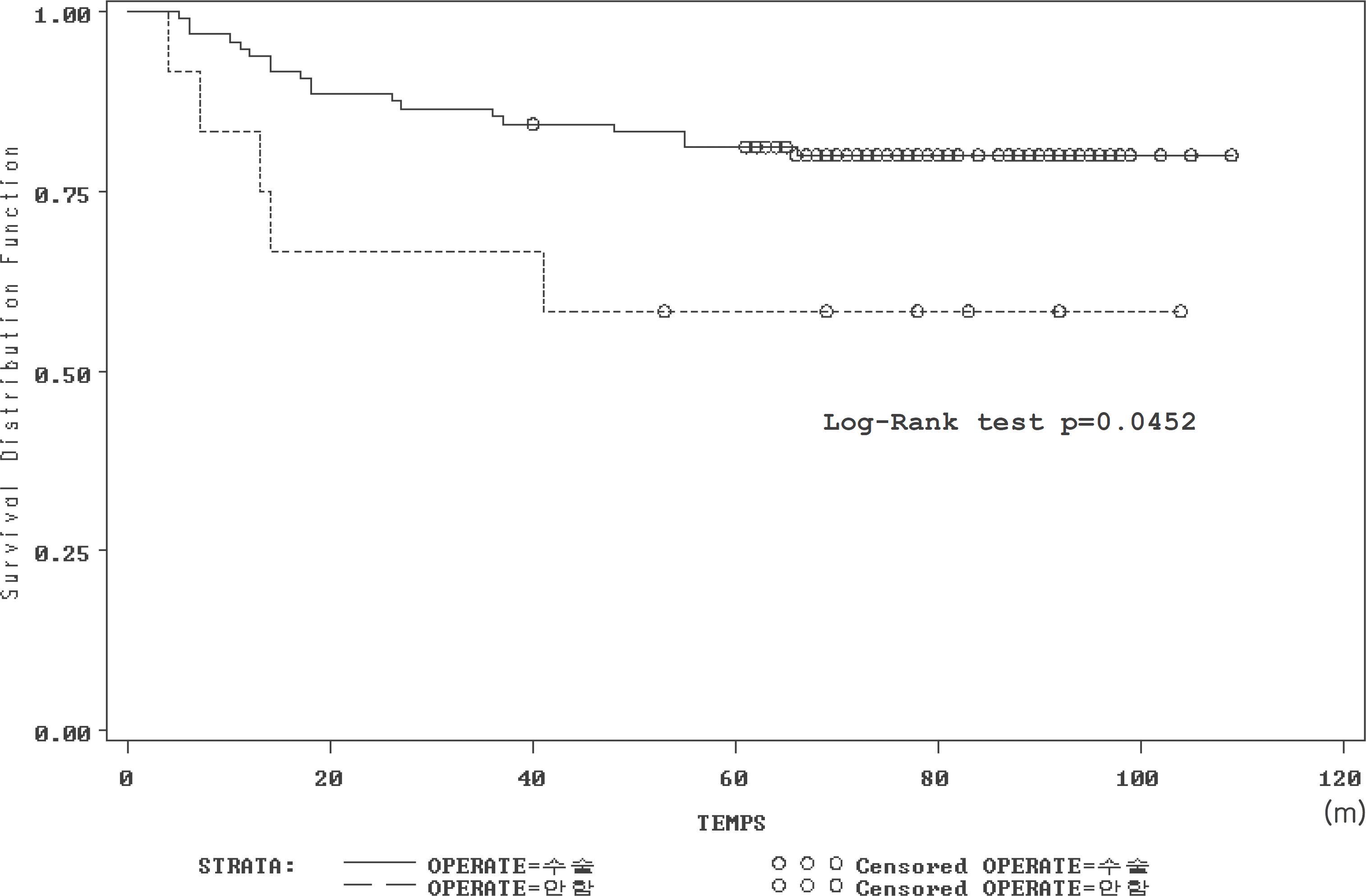 | Figure 6.Survival curve produced by the Kaplan-Meier method for the 108 retinoblastoma patients according to operation status. |
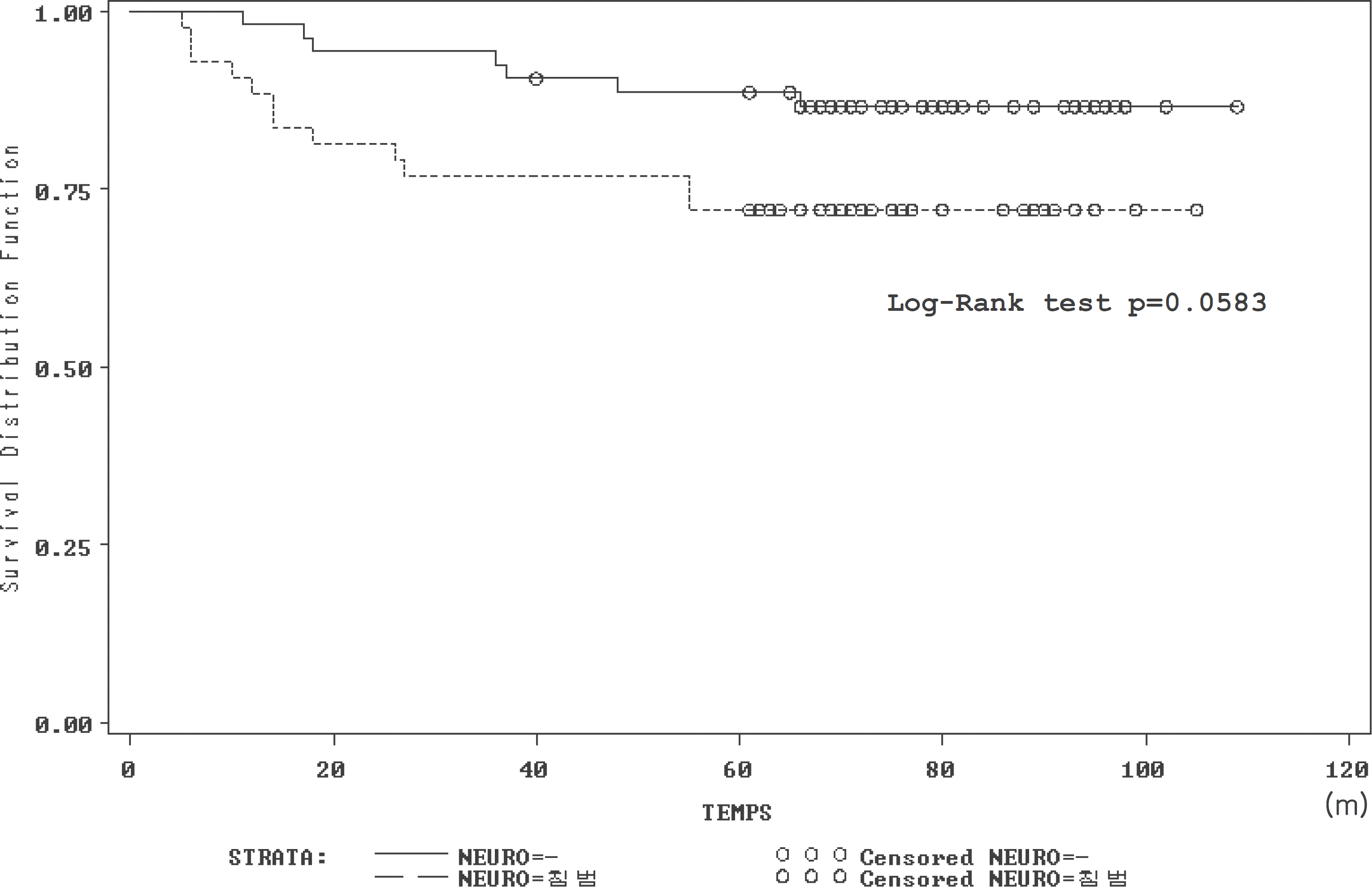 | Figure 7.Survival curve produced by the Kaplan-Meier method for the 108 retinoblastoma patients according to optic nerve infiltration. |
Table 1.
Prognostic factors for retinoblastoma in Korea (1991∼1993)
|
Crude |
Adjusted* |
Adjusted† |
|||
|---|---|---|---|---|---|
| Dead n (%) | Alive n (%) | RR (95%CI) | RR (95%CI) | RR (95%CI) | |
| Age at diagnosis | |||||
| ≤1y | 14 (20.3) | 55 (79.7) | 1 | 1 | 1 |
| ≤2y | 10 (25.6) | 29 (74.4) | 1.32 (0.59–2.98) | 1.88 (0.79–4.45) | 1.92 (0.74–4.97) |
| Sex | |||||
| Male | 7 (14.9) | 40 (85.1) | 1 | 1 | 1 |
| Female | 17 (27.9) | 44 (72.1) | 2.09 (0.87–5.05) | 2.21 (0.91–5.36) | 2.28 (0.85–6.10) |
| Bilaterality‡ | |||||
| unilateral | 14 (16.9) | 69 (83.1) | 1 | 1 | 1 |
| bilateral | 10 (40.0) | 15 (80.2) | 2.62 (1.16–5.89) | 3.15 (1.33–7.44) | 3.20 (1.19–8.66) |
| Operation | |||||
| - | 5 (41.7) | 7 (58.3) | 1 | – | – |
| + | 19 (19.8) | 77 (80.2) | 0.38 (0.14–1.02) | – | – |
| Optic nerve invasion | |||||
| - | 7 (13.2) | 46 (86.8) | 1 | – | 1 |
| + | 12 (27.9) | 31 (72.1) | 2.39 (0.94–6.07) | – | 2.39 (0.94–6.10) |
Table 2.
Reese-Ellsworth classification of 108 retinoblastoma patients (eyes)
| R-E class |
1 |
2 |
3 |
4 |
5 |
unspecified | |||||
|---|---|---|---|---|---|---|---|---|---|---|---|
| a | b | a | b | a | b | a | b | a | b | ||
| Bilateral | |||||||||||
| Rt (25) | 1 | 1 | 2 | – | – | 2 | – | 1 | 8 | 7 | 3 |
| Lt (25) | 2 | 2 | 3 | 1 | 3 | 1 | – | 1 | 4 | 3 | 5 |
| Unilateral (83) | 1 | – | 13 | 2 | 1 | 3 | – | 3 | 24 | 23 | 13 |
| Total | 4 | 3 | 18 | 3 | 4 | 6 | – | 5 | 36 | 33 | 21 |
Table 3.
Types of treatment for 108 retinoblastoma patients (no)




 PDF
PDF ePub
ePub Citation
Citation Print
Print


 XML Download
XML Download